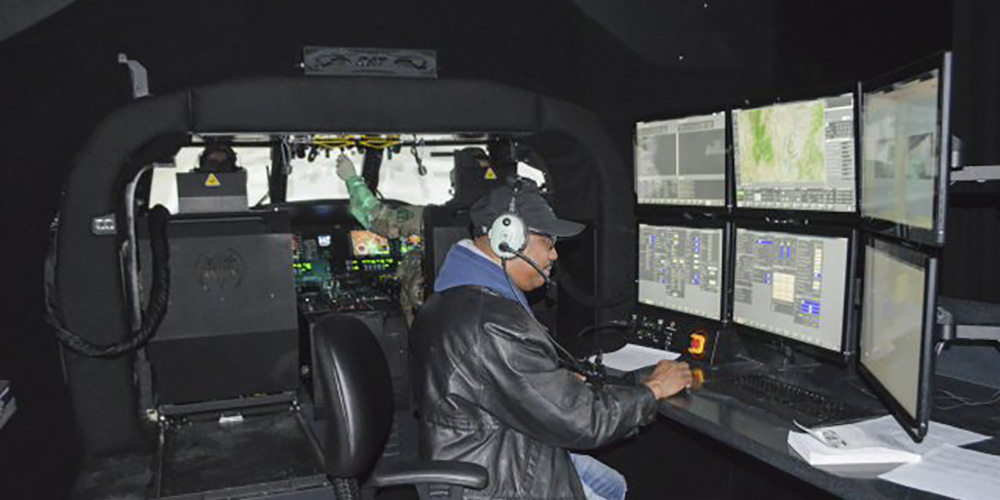
by Brian Beall
Army aviators seeking flight training on the UH-60M Black Hawk have a new, state-of-the-art option at their disposal, thanks to a joint effort of the U.S. Army Aviation and Missile Research, Development and Engineering Center (AMRDEC) and the Program Executive Office for Aviation at Redstone Arsenal, Alabama.

Soldiers of the 1st Armored Division’s Combat Aviation Brigade conduct training on the Black Hawk Aircrew Trainer (BAT) in January at Biggs Army Airfield, Fort Bliss, Texas. The BAT reuses cockpits from Black Hawk helicopters on the brink of demilitarization, which provides a realistic training experience for a relatively low cost. (U.S. Army photo)
The Black Hawk Aircrew Trainer (BAT) provides Army UH-60M aviators with a high-fidelity, fully immersive flight training experience. It’s currently in operation at Fort Bliss, Texas, and Des Moines, Iowa. Up to 17 other locations might receive the BAT simulator, as well.
AMRDEC is home to the Systems Simulation, Software and Integration (S3I) Directorate, which provides the Army and DOD a full suite of technical management, software engineering and systems simulation and development for aviation and missile systems. S3I’s System Simulation and Development Directorate, augmented by systems engineering and technical assistance contractors from SAIC, led the effort to develop the BAT with oversight and funding from PEO Aviation’s Utility Helicopters Project Office (UHPO), based on requirements established by the U.S. Army Aviation Center of Excellence at Fort Rucker, Alabama, and UHPO.
IP APPROACH KEYS DEVELOPMENT
AMRDEC and PEO Aviation fielded the first trainer to the UH-60M New Equipment Training Team at Fort Bliss on Dec. 16, 2015, under budget and six months ahead of schedule.
Creation of the training simulator began in October 2012, with the goal of developing an open architecture solution that included full government purpose rights for the system hardware and software to guarantee rapid integration and fielding of UH-60M platform updates. That approach was underpinned by the tenets of Better Buying Power 3.0 and aims to serve as a model for future training device development. The team emphasized modular open systems architecture throughout the development of the simulator, leveraging commercial off-the-shelf hardware where possible, and based on requirements that were defined early in the process. Given the simulator’s modular hardware and software, AMRDEC and PEO Aviation anticipate that the BAT will achieve 25 percent savings (compared with a non-modular alternative) for the Army across its life cycle.

Greg Shirley, an AMRDEC employee of the Utility Helicopter Project Office, instructs Soldiers training on the Black Hawk Aircrew Trainer (BAT) at Fort Bliss, Texas. The BAT is a true collaborative effort: AMRDEC and PEO Aviation co-developed the first iteration, and PEO STRI will maintain and sustain the program. (U.S. Army photo)
“Great outcomes are not driven by technical excellence alone,” said James Lackey, AMRDEC director. “We must also add enterprise collaboration. A collaborative effort doesn’t ‘keep in house’ or ‘stay in their lane.’ They instead reach out and recognize where and when certain facts of other organizational technical excellence make sense to pull together, integrate and derive great outcomes.”
For example, to enhance the reality of the training experience, the simulator incorporates UH-60A cockpits previously scheduled for demilitarization. Additionally, AMRDEC leveraged previously developed software interfaces and flight models to support the final simulator software package. Ultimately, the blend of government-furnished and commercially procured hardware and software provides UH-60M aviators with a mobile, concurrent and organically maintained flight training simulator.
For future iterations of the BAT, a team of program executive offices supporting aviation, simulation, training and instrumentation, and special operations forces will lead the procurement of the next set of simulator devices. This teaming approach ensures future collaboration for software and hardware updates throughout the life cycle of the simulators program. Ultimately, the PEO for Simulation, Training and Instrumentation (PEO STRI) will lead the program through its maintenance and sustainment phases.







